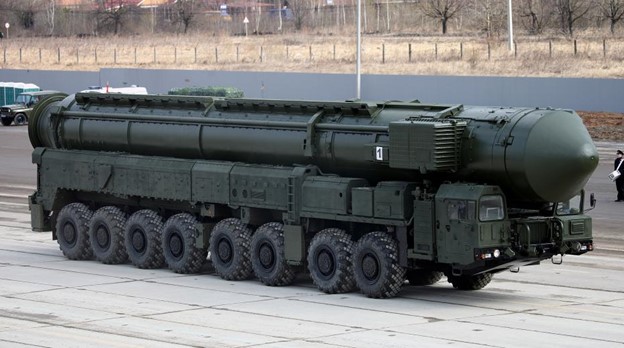While Russia is celebrating May Day at home this week, it is also growing closer to breaching the threshold triggering a nuclear event in Western Europe. Military analysts in Washington consider the recent deployment of Russian tactical nuclear weapons in Belarus a political sign designed to unnerve the North Atlantic Treaty Organization’s (NATO) easternmost flank. Alexander Taranov, of the Jamestown Foundation calls it “practical preparation for nuclear escalation.” Last week the Kremlin publicly repeated its threat of nuclear war against the West. It immediately followed the US Congress’ vote to provide $61 billion in military assistance to Ukraine.
Up for debate is whether Russia’s storage of nuclear warheads in Belarus is short-term preparation for their operational use. Russian Foreign Minister Sergei Lavrov openly declared that increasing aid to Ukraine increases the threat of a direct military clash. From Moscow’s perspective, he points out, Ukraine is backed by three nuclear states, including the US, UK, and France. He uses it to justify the Kremlin’s moves in Belarus as Russia considers the situation a serious strategic risk. The nuclear environment in Europe is moving beyond simple rhetoric this spring.
Russian-Belarus preparations for an attack on the West include war gaming a simulated nuclear event in Ukraine and Eastern Europe. The operating assumption for the games is that the West is “morally too weak to respond with retaliatory strikes,” according to Taranov. The representative for national defense of the Belarusian opposition-in-exile’s United Transitional Cabinet and former commander of the Belarusian 38th Separate Guards Air Assault Brigade (Brest), Valery Sahashchyk, says that the militaries are war-gaming and preparing for an attack on Lithuania. Last week the publication RIA Novosti suggested that the Kremlin may take matters into its own hands and that Russia is fighting a “long war” against the collective West and Ukraine.
Just over a month ago, the Federation of American Scientists (FAS) confirmed the establishment of a nuclear warhead storage facility near Asipovichy, Belarus, where, according to Taranov, the 1405th Artillery Ammunition Base is located. The 465th Missile Brigade is almost co-located and supplied with Russian Iskander-M operational-tactical missile (RMB) systems that are also known as TNW carriers. Pre-deploying tactical nuclear weapons (TNWs) raises the potential that Russia could choose to use them should the war in Ukraine go badly this summer.
Western powers are divided on how to view the Russian nuclear moves. Some military planners are arguing that the West needs to be prepared, despite the possibility that Putin is simply posturing and not preparing for war. Other Western commentators suggest it is only posturing since prior to the recent nuclear deployment in Belarus, Russia already had the capability to launch a strike in Eastern Europe using its modernized nuclear weapons storage facilities in Kaliningrad.
Taranov points out that the Belarusian nuclear site is only modernized with added perimeter security and an access point and that “No underground bunker-type fortifications, designed for the long-term storage of TNWs… were built on the Belarusian base’s territory. Instead, the nuclear warheads were placed in one of the arsenals of the ammunition base, which also stores operational-tactical missiles for the Iskander-M system.” He says this co-location with their launch vehicles is an indication that a repair and maintenance base has been organized there to support and prepare the TNWs for operational use. Personnel on the site are likely tasked with fitting the nuclear warheads on the missiles.
What makes this more concerning is that during a peacetime environment, the standard Russian practice is to store TNWs in a special bunker-type fortified facility while RMBs typically are located off base. Military procedures in the past called for moving TNWs off base to the TNW carrier and delivery vehicle site only after receiving an order or special command from: 1) the Supreme Commander-in-Chief, 2) the Minister of Defense, and 3) the Chief of the Russian General staff. Co-positioning marks a change in standard operating procedures that indicates the weapons are, essentially, in field-ready conditions. This reduces the time to place the nuclear warheads on the missiles. This “indicates preparation for operational use,” according to Taranov.
There are additional signs that Putin is prepping for an escalation in the Ukrainian conflict. The Polish government says Russian Aerospace Forces are using Belarusian-based Kh-55 nuclear-capable cruise missiles with imitators of nuclear warheads against targets in Poland and Ukraine. This points to Russia’s practicing for at minimum of a tactical nuclear strike. The summer months may become very active in Europe if Putin sees it as an opportune time to act while the US is in the middle of a presidential election.
Daria Novak served in the U.S. State Dept.
Photo: RS-24 Yars (SS-27 Mod 2) ICBM. Photo: Wikimedia Commons / Vitaly V. Kuzmin
